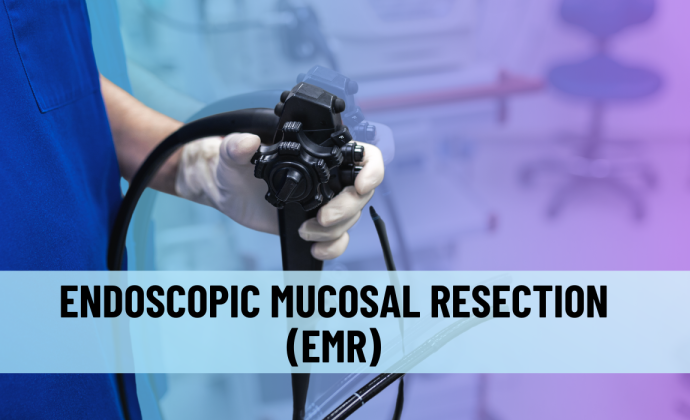
Endoscopic Mucosal Resection (EMR)
If you or someone you know has a tumor or lesion just below the surface of the gastrointestinal (GI) tract wall, your doctor might recommend removing it through a procedure called Endoscopic Mucosal Resection (EMR). This procedure offers a minimally invasive solution for addressing cancer or precancerous lesions in the GI tract, providing more accurate local staging assessments compared to other ablation therapies like argon plasma coagulation (APC), photodynamic therapy, or radiofrequency ablation (RFA).
EMR techniques: a. snare polypectomy; b. strip biopsy method (source: abdominalkey.com)
What is Endoscopic Mucosal Resection (EMR)?
Endoscopic Mucosal Resection (EMR) is a minimally invasive therapeutic procedure performed with an endoscope to remove cancerous or precancerous lesions in the GI tract. EMR allows doctors to accurately assess the local severity of the disease. There are two EMR methods: suction and non-suction. In the non-suction method, a submucosal injection is used to separate the muscularis propria (muscle layer) from the lesion, reducing the risk of perforation (holes forming in the organ wall).
Who Needs EMR?
EMR is used to remove tumors located in the mucosa—the outermost layer lining the organs of the GI tract. This procedure is effective for:
1. Removing tumors that have not penetrated deeper layers of the GI tract wall and are less than 2 cm in diameter or slightly larger.
2. Areas of abnormal tissue, precancerous lesions, or superficial cancerous tumors in the stomach or small intestine with clear boundaries (separable from surrounding tissue).
3. Early-stage esophageal cancer or colon cancer.
4. Barrett’s esophagus.
Doctors will recommend EMR if the abnormal area or cancer has not spread to surrounding tissues.
Preparing for the EMR Procedure
Before undergoing an EMR procedure, several steps may need to be taken:
1. For Lower GI Tract Procedures: Follow a liquid diet with laxatives or an enema to cleanse the bowel.
2. For Upper GI Tract Procedures: Fast (no food or drink) for 12 hours before the procedure to ensure the upper GI tract is clear of food.
3. Follow Doctor’s Instructions: Carefully adhere to any pre-procedure guidelines provided by your doctor.
Recovery After the EMR Procedure
After the EMR procedure, patients will be monitored in a recovery room until the effects of the sedative (anesthesia) wear off. During recovery, patients might experience symptoms such as a sore throat, nausea or vomiting, and bloating. While complications like bleeding and perforation are rare, they can occur.
Conclusion
Endoscopic Mucosal Resection (EMR) is a minimally invasive procedure effective for removing precancerous and superficial cancerous lesions in the GI tract. With proper preparation and post-procedure monitoring, EMR can be a safe and effective solution to prevent further cancer development. For more information or to determine if you are a suitable candidate for EMR, consult your doctor.
This article has been reviewed by Dr. Virly Nanda Muzellina, SpPD, K-GEH
Image source:
Getty Images
EMR techniques. Abdominal Key: Fastest Abdominal Insight Engine. Abdominalkey.com
Source:
Mannath J, Ragunath K. Endoscopic mucosal resection: who and how? Therap Adv Gastroenterol. 2011 Sep;4(5):275-82. doi: 10.1177/1756283X10388683. PMID: 21941594; PMCID: PMC3165204.
Johns Hopkins Medicine. Endoscopic Mucosal Resection. Retrivied from: https://www.hopkinsmedicine.org/health/treatment-tests-and-therapies/endoscopic-mucosal-resection
Guy’s and St Thomas’ NHS Foundation Trust (guysandstthomas.nhs.uk). (2023). Endoscopic Mucosal Resection: an Overview. Retrivied from: https://www.guysandstthomas.nhs.uk/health-information/endoscopic-muscosal-resection Top of Form





 Users Today : 137
Users Today : 137 Total views : 2130484
Total views : 2130484 Who's Online : 4
Who's Online : 4